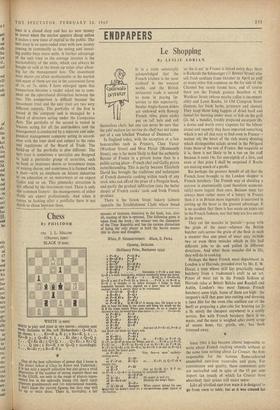Chess
By PHILIDOR 219. J. L. MILLINS (Observer, 1920) BLACK (8 men)
WHITE (9 men) WHITE to play and mate in two moves ; solution next Week. Solution to No. 218 (Richardson): Q—Kc 3,
0,9 threat. . . . Kt—B 4, K 2 Kt—K 5. . . Isst—.B: a Q—Kt . . . Kt else; 2 (t-Q . XKt ch; 2 QXQ. I • .. QXKL; 2 tX14. • • . else ; 2 Kt—K 5 or Q—Q x accordingly. • . B—Kt 7 ; 2 R—K B 4. * The of the best collections of games that I know is 4 he Soviet School of Chess by Kotov and Yudovitch : 't • is not only a superb collection but also gives a vivid Lmpression of `the number of strong masters there are In the USSR, not only in the range of players repre- sented but in the appendix listing (for April 5957) ttineteen grandmasters and Ito international masters. LI don't know the current figures, but they may well
up to twice these. There is, inevitably, a fair amount of tiresome dialectics in the book, but, after all, reading of this is optional. The following game is taken from the book ; the winner was the champion of the Tatar Republic and has the curious distinction of being the only player to hold the Soviet master title in chess and draughts.
White, P. NEZIIMETDINOV. Black, E. PAOLI.
Opening, SICILIAN.
(Brilliancy Prize, Bucharest 1954)
B 4
a Ke— K 8 3 3 Kt x K P-34 P 4 t— Kt 10 —1Q 3 P--Q K 8 3
R 3
B B— P—K Q—B . . . Nowadays 7 P-7.13 4 and then la..-15 3 is more fashionable ,e without necessiwity being any better /. . . B—K z ' 7 . . . B—Q 2; 0 0 0, Kt—B 3. and if 9 P—K Kt. 4, then 9 P—R 3; to B—R 4, R—B I; is thought to be rather stronger. I hedge in these comments because they depend on a great deal of detailed analysis which is alwaflQikely to be overturned. 8 0-0-0 B oR—Ke —a P—K Kt 4 Kt—B 3 tr B—K 3 P—R sa P—K R 4 Q R—B z.? A wrong idea. He hopes to be able to keep his king in the centre and bring his attack on the Q B file home before White gets through. As he is unable to succeed in this, he would have done better in play 1 2 . . o 0 0. 13 P—Kt 5 P x P • PxPRt—K 4 Q—K, s KI—Ke P-8 K • B Kt Q x Be—B 5 • P—B el. . . And not 18 P—Kt 67, P—B 31 and Black can block the king's side.
s8 es# K—Kt r P—Ke 4
so P—Kt 6! P—K 4 so. .. P x Kt; as P x P ch,
.
K x P; 22 Q—P ch wins for white and 20 P—B 3; 21 P x P, P x Kt (21 . XP; 22 Kt—Q 5 or 22 Kt X B); 22 P x B ch, K x P; 23 SQ"..K1 4 eh, K—B 2; 24 Kt—K 6 ch and 25 R—Q 4 with much the better game. ar P—Ke 31 . . . Very fine--a most. unlikely-
looking move.
az . .Q x Kt as P x.11 ch K--Q z 22 . . . K xP ; 23 QxP ch is equally lost.
a3 QxP PxKe
24 B x P . . . Not 24 QxR, Qx B P ch; 25 K—It Q—B 6 ch draw Ping by perpetual check. 24 . . . xB 25 K-11 r R—R 7 oh Hemight as well try.. 26 B—Kt 6 chi . . . Blocking the king's flight.
a6 . . . R—B a 27 Q x Kt ch Resigns White cannot defend his own
hing—but he doesn't need to; a cut-and-thrust game typical of the Sicilian.


































 Previous page
Previous page